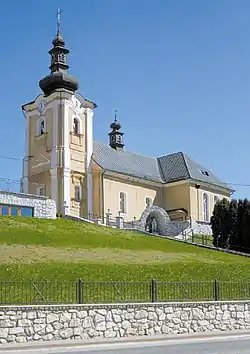Zipser Germans
The Zipser Germans, Zipser Saxons, or, simply, just Zipsers (German: Zipser[1] or Zipser Deutsche, Romanian: Țipțeri, Hungarian: Cipszer, Slovak: Spišský Nemci) are a German-speaking (more specifically Zipser German-speaking as native dialect) sub-ethnic group in Central-Eastern Europe and national minority in both Slovakia and Romania (there are also Zipser German settlements in the Zakarpattia Oblast, in the historical region of Carpathian Ruthenia, present-day western Ukraine).[2] Along with the Sudeten Germans (German: Sudetendeutsche), the Zipser Germans were one of the two most important ethnic German groups in the former Czechoslovakia. An occasional variation of their name as 'Tzipsers' can also be found in academic articles.[3] Former Slovak President Rudolf Schuster is partly Zipser German and grew up in Medzev (German: Metzenseifen).[4]
German: Zipser, Zipser Deutsche, and/or Zipser Sachsen | |
|---|---|
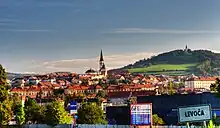 | |
| Regions with significant populations | |
| Slovakia and Romania (more specifically in present-day Suceava County, Bukovina, northeastern Romania as well as Maramureș in northern Transylvania) | |
| Languages | |
| German (with the Zipser German dialect) | |
| Religion | |
| Roman Catholicism and Evangelical Lutheranism | |
| Related ethnic groups | |
| Germans, Germans of Romania (including, most notably, Transylvanian Saxons and Bukovina Germans), German diaspora, Austrians, Flemings, or Luxembourgers | |
Native to Central-Eastern Europe, more specifically to present-day Spiš region, north-eastern Slovakia (since the High Middle Ages onwards) as well as Bukovina and Maramureș, Romania (since the Modern Age onwards). |
The Zipser Germans were previously native to the Szepes County (German: Zips; Slovak: Spiš, Hungarian: Szepes) of Upper Hungary—today mostly north-eastern Slovakia—as that region was settled by colonists from present-day central Germany (and other parts of contemporary Germany) during the High Middle Ages, more specifically beginning in the mid 12th century, as part of the Ostsiedlung.[5] Beginning in at least the 18th century, many members of this German ethnic sub-group migrated to southern Bukovina,[6][7] Maramureș, Transylvania, and in the mountainous Banat (all of the aforementioned regions situated in contemporary Romania).[8] Most of the Zipser German community in Romania lives in Maramureș County and across the Rodna Mountains respectively.
Occasionally, Zipser Germans are also referred to as Zipser Saxons (Hungarian: szepesi szászok or szepességi szászok, German: Zipser Sachsen), a name stemming from their geographic origin of initial settlement during medieval times corresponding to the present-day Spiš (German: Zips) region situated in north-eastern Slovakia. The county (German: Komitat) where they settled in the beginning is known in Hungarian as 'Szepes'.[9] Alongside the Transylvanian Saxons in Transylvania, contemporary central Romania, and the Baltic Germans from Estonia and Latvia, the Zipser Germans are one of the three oldest German-speaking and ethnic German groups in Central and Eastern Europe, having continuously been living there since the High Middle Ages onwards.[10]
The Zipser Germans can also be equated with the Germans of Slovakia (German: Slowakeideutsche) and are part of the broader group of Carpathian Germans (German: Karpatendeutsche), having chiefly been referred to as such along with the Germans of Carpathian Ruthenia since the end of World War II onwards. They are also part of the Germans of Romania. The small community of Zipsers still living in Suceava County, southern Bukovina, Romania, can be perceived as part of the Bukovina German community as well, in the greater sense that is.[11]
Medieval history

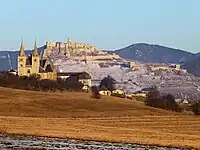
German settlers were invited to settle in the Spiš region across the High Tatras, present-day Slovakia, then Szepes County (German: Komitat Zips) of Upper Hungary in the Kingdom of Hungary, beginning in the mid 12th century by former King of Hungary Géza II of Hungary. These settlers' occupations ranged from miners and traders to builders. The last wave of German colonists arrived during the 15th century, towards the end of the Middle Ages (or the Late Middle Ages).[12][13]
As in the cases of other historical regions from Central and Eastern Europe, this migration of German settlers at the invitation of local kings (known as Ostsiedlung in German historiography) from several Central-Eastern European countries had the main goal to enrich the local medieval communities with more trade and urbanization as well as to fortify them in the wake of the Mongol invasion (as did the Transylvanian Saxons in Transylvania, another former region of the Kingdom of Hungary during the Middle Ages).

In the particular case of present-day Slovakia, these German settlers stemmed from lower Rhine river valley (including present-day Luxembourg), Flanders, Saxony, and Silesia (in present-day south-eastern Poland).[14] They governed themselves under the Zipser Willkür, a particular medieval German law (more specifically German town law) which they developed there under a certain degree of local autonomy provided by the Hungarian monarch. Zipser Willkür is the oldest form of German law from Slovakia.[15]
In the passing of time, as in the case of other local communities in Central-Eastern Europe colonized with ethnic Germans during the Middle Ages, these newly arrived German settlers became the dominant class and the majority ethnic group in the towns and villages they had either founded or re-populated (as other settlements were previously founded by Slovaks). They eventually became collectively known as Zipser Germans given the fact that they helped develop Szepes County. They are sometimes referred to as Zipser Saxons (German: Zipser Sachsen) as well. As in the case of the Transylvanian Saxons in Transylvania (another Central-Eastern European historical region which previously belonged to the medieval Kingdom of Hungary), the Zipser Germans founded imposing castles and fortified urban settlements.
Modern period history
During the modern period, as it was the case of other ethnic German groups from non-native German Central and Eastern European countries, the population of Zipser Germans gradually declined on the territory of contemporary Slovakia. Zipser German populations were still significant in several parts of central Slovakia though, but not as significant as they once were during the Middle Ages (both in absolute numbers and in social status). They also underwent forced Magyarization during the 19th century.
Beginning in at least the 18th century, many Zipser Germans from the territory of present-day Slovakia emigrated southward to Habsburg-ruled and, later on, Austrian-ruled Bukovina (Romanian: Bucovina) and also to Maramureș, where they established or intermixed in already established Romanian rural settlements but also settled in the towns. Many of them were miners, both in Bukovina and in Maramureș.


 The Kežmarok Castle in Kežmarok
The Kežmarok Castle in Kežmarok

 Borșa (German: Borscha), or Baia Borșa as it is also known in Romanian, a small town in Maramureș which was home to a Zipser German community in the past as well
Borșa (German: Borscha), or Baia Borșa as it is also known in Romanian, a small town in Maramureș which was home to a Zipser German community in the past as well
20th century and contemporary history
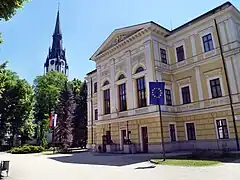
During and after World War II, most Zipsers evacuated or were expelled to West Germany. A community of speakers remains in the Zips village of Chmeľnica (German: Hopgarten; their distinctive dialect is called 'Outzäpsersch', German: Altzipserisch, literally Old Zipserish),[16] and others remain in Romania where they and other German-speaking minority groups are currently represented by the Democratic Forum of Germans in Romania (FDGR/DFDR) at political, cultural, and administrative levels.
Some notable localities in southern Bukovina (contemporary Suceava County) previously inhabited by a significant number of Zipser Germans include Iacobeni (German: Jakobeny), Cârlibaba (German: Mariensee/Ludwigsdorf), and Fundu Moldovei (German: Luisenthal or Louisenthal).[17]
To this day, sparse Zipser German communities still reside in southern Bukovina and northern Transylvania, in Maramureș/Maramureș County more specifically, where they are also officially represented at political and administrative level (albeit only to a lesser extent) after the latest Romanian locations which were held in September 2020.
| Total seats of the FDGR/DFDR in Vișeu de Sus (German: Oberwischau), Maramureș (German: Maramorosch) | As per the results of the 2020 Romanian local elections | 1 / 18 |
Nonetheless, most of the remaining Zipser Germans in Romania live in Maramureș, northern Transylvania. Therefore, the main localities still populated by Zipser Germans in Maramureș County according to the 2011 Romanian census are the following ones, both urban settlements (a town and a municipality):
- Vișeu de Sus (German: Oberwischau)
- Baia Mare (German: Frauendorf or Groß-Neustadt)
Historical occupations

In general, all the more with respect to Maramureș and Bucovina, the Zipser Germans were mainly:
- Miners;
- Lumberjacks;
- Farmers.
Thus, from a historical point of view, their societies are mostly characterised by the rural character of their traditional occupations over the passing of time.

In medieval times, the historical occupations of the Zipser Germans in Slovakia were the following ones (as it was the case of other German-speaking groups during the Ostsiedlung as part of an emerging feudal system):
- Castle builders or fortification builders in general;
- Knights/soldiers;
- Blacksmiths;
- Carpenters;
- Cobblers (hence e.g. the family name Schuster);
- Miners;
- Lumberjacks;
- Farmers.
As opposed to the Modern Age societies of Zipser Germans in present-day Romania, the societies of Zipser German in medieval contemporary Slovakia had both a rural and urban character, also revitalising urbanisation on previously existing Slavic/Slovakian towns and cities.
Demographics
| Year | Pop. | ±% |
|---|---|---|
| 1930 | 148,000 | — |
| 1946 | 24,000 | −83.8% |
| 1947 | 20,000 | −16.7% |
| Population statistics referring to Czechoslovakia and Slovakia only. Source: [18][19] | ||
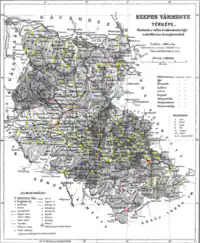
Once, the Zipser Germans had a significant and sizeable demographic presence in Czechoslovakia and subsequently also in Slovakia, but their numbers have been constantly decreasing over the years well into the 21st century. Nowadays, relatively few live in Slovakia and even fewer Zipsers live in Romania as well.[18] The main reason why their numbers decreased considerably after World War II is because they had been expelled, as was the case of the Sudeten Germans or other German groups from Central and Eastern Europe (German: Ostmitteleuropa), thereby resettling in either Austria or West Germany.
Media
In Slovakia, the Zipser Germans and the Carpathian Germans have their own monthly publication/newspaper which is called Karpatenblatt (the publication also has a YouTube channel).[20][21]
Cultural and social life in Romania
In Romania, the Zipser Germans hold a festival on yearly basis (just as other German-speaking and German-stemming ethnic minorities all across Romania) which is called Zipsertreff.[22] The Zipsertreff is held in Vișeu de Sus (German: Oberwischau) in Maramureș and is an important celebration of the local Zipser German heritage and culture.
Notable Zipser Germans
- Rudolf Schuster, partly Zipser German, former President of Slovakia
- Ottó Herman, polymath
- Gerhard Cerny, writer
- Johann Generisch, historian
- Hugo Weczerka, historian
Gallery
.jpg.webp)







 The Roman Catholic cathedral at Spišské Podhradie (German: Kirchdrauf)
The Roman Catholic cathedral at Spišské Podhradie (German: Kirchdrauf)


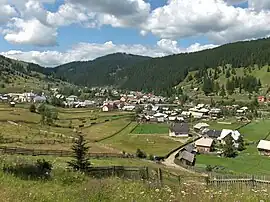

.JPG.webp)
.JPG.webp)

.JPG.webp)
See also
Further reading
- Gisela Richter, Anneliese Thudt: Die Mundarten der sog. Zipser in Oberwischau. In: Forschungen zur Volks- und Landeskunde. Volume 8, 1985, pages 27–48 (in German).
- Oskar Hadbawnik: Die Zipser in der Bukowina. (i.e. The Zipsers in Bukovina) published by Landsmannschaft der Buchenlanddeutschen e.V. München, Bavaria, West Germany, 1986 via Google Books (in German).
- Povești din folclorul germanilor din România by Roland Schenn, Corint publishing house, 2014 (in Romanian)
External links
- Frozen Spis (Spiš), Slovakia, a short YouTube panoramic video clip showcasing the region of Spiš (German: Zips) from north-eastern Slovakia;
- Zipser Doku, a brief bilingual German-Romanian documentary on YouTube on the life of the Zipser German community of Vișeu de Sus (German: Oberwischau), Maramureș, Maramureș County, northern Romania;
- "SÜSSE HEIMAT ZIPSEREI" Trailer zum Dokumentarfilm über die deutsche Minderheit, a trailer on YouTube on a documentary on the Zipser German minority in Vișeu de Sus (German: Oberwischau), Maramureș, Maramureș County, northern Romania;
- Schaufenster Enkelgeneration - Alfred Ludovic Fellner (Oberwischau/ Vişeu de Sus), a brief documentary on YouTube by Goethe-Institut Bucharest on the Zipser German community in Vișeu de Sus (German: Oberwischau), Maramureș, Maramureș County, northern Romania;
- Zipseri/Țipțeri, a Romanian television (TVR 2) documentary on the Zipser German community in Romania.
References
- Democratic Forum of Germans in Romania, Oberwischau/Vișeu de Sus branch. "Demokratisches Forum der Deutschen in Oberwischau" (in German). Retrieved 14 January 2023.
- Scridon Ioana, Oana-Ramona Ilovan (March 2016). "Approaching the Other in the Zipser Community Identity Issues and Methodological Insights into Geographical Cross-Cultural Research". Transylvanian Review. Retrieved 17 April 2023.
- Radu Săgeată; Mircea Buza; Traian Crăcea (2017). "The Germans in Romania, with special regard to the Transylvanian Saxons" (PDF). Mitteilungen der Österreichischen Geographischen Gesellschaft. Retrieved 20 April 2023.
- Friedrich Gottas. "Sachsen (Zips)". Alpen-Adria, Universität Klagenfurt (in German). Retrieved 22 June 2020.
- Karl Julius Schröer, Die deutschen Mundarten des ungrischen Berglandes (1864)
- Oskar Hadbawnik, Die Zipser in der Bukowina (1968) discusses the Zipserfest held in Jakobeny in 1936 to commemorate 150 years since the Zipsers migrated to Jakobeny in 1786.
- І. Я. Яцюк, Тернопільський національний педагогічний університет ім. Володимира Гнатюка, Наукові записки. Серія “Філологічна”, УДК 81’282.4:811.112.2(477): Lexikalische Besonderheiten Deutscher Dialekte in Galizien und der Bukowina: “Die Siedler in den ursprünglichen Bergwerksgemeinden im Südwesten der Bukowina sprachen Zipserisch und zwar Gründlerisch, wie es in der Unterzips gesprochen wurde. Dabei wurde [v] im Anlaut wie [b] ausgesprochen: Werke – berka, weh – be, Schwester – schbesta. Anlautendes [b] wurde zu [p]: Brot – prot, Brücke – prik.”
- Jacob Steigerwald, Tracing Romania's heterogeneous German minority (1985), page 8
- "Szepes County". Donau Schwaben USA. Retrieved 14 January 2023.
- Victor Rouă (14 January 2023). "The History Of The Zipser Germans In Central Europe". The Dockyards. Retrieved 19 February 2023.
- Sophie A. Welsch, Ph.D. (March 1986). "The Bukovina-Germans During the Habsburg Period: Settlement, Ethnic Interaction, Contributions" (PDF). Immigrants & Minorities, vol. 5, no. 1. Retrieved 17 April 2023.
- Ioana Scridon and Oana-Ramona Ilovan (2015). "The Zipsers' Ethnic Identity in Vişeu de Sus/Oberwischau, Romania, in the Context of Inter-Ethnic Relationships" (PDF). Mitteilungen der Österreichischen Geographischen Gesellschaft, 157. Jg. (Jahresband), Wien 2015, S. 151–168. Retrieved 18 January 2023.
- "Grupul etnic al țipserilor din România" (PDF). Studiu diacronic al schimbărilor de reprezentare a spațiului identitar etnic în Vișeu de Sus, Maramureș, Ph.D. thesis (in Romanian). 2012. Retrieved 18 January 2023.
- "Cipszer". Encyclopedia Britannica. Retrieved 14 January 2023.
- Heikki Pihlajamäki, Markus D. Dubber, and Mark Godfrey (28 June 2018). The Oxford Handbook of European Legal History. p. 503. ISBN 978-0-19-108837-7.
{{cite book}}: CS1 maint: multiple names: authors list (link) - Somewhat confusingly, literature on the language also uses 'Altzipserisch' in two other ways: to refer to the dialect of the Upper Zips as contrasted with 'Gründlerisch', and to refer to the original Central German (German: Gründlerisch) dialect of the speakers who migrated to Romania, as contrasted with the Upper-Austrian-influenced dialect they now speak. For example, Claus Stephani in Zipser Mära und Kasska (1989) writes that the later settlers 'sprachen Oberösterreichisch, die anderen eine Gründler Mundart: Altzipserisch' (spoke Upper Austrian, [while] the others [spoke] a Gründler dialect: Old Zipserish).
- Oskar Hadbawnik (25 June 2006). "Louisenthal". Bukovina Society. Retrieved 29 September 2022.
- "German (Saxon) Heritage of Spiš". Tatravelo. Retrieved 13 April 2023.
- "Slovakia Cultural Groups". FamilySearch. Retrieved 13 April 2023.
- "Karpatenblatt - Magazin Der Deutschen In Der Slowakei". Karpatenblatt (in German). Retrieved 16 January 2023.
- "The official YouTube channel of Karpatenblatt magazine". Karpatenblatt on YouTube (in German). Retrieved 16 January 2023.
- Björn Reinhardt (14 August 2022). "Zipsertreff 2022". Youtube (in German). Retrieved 16 January 2023.
